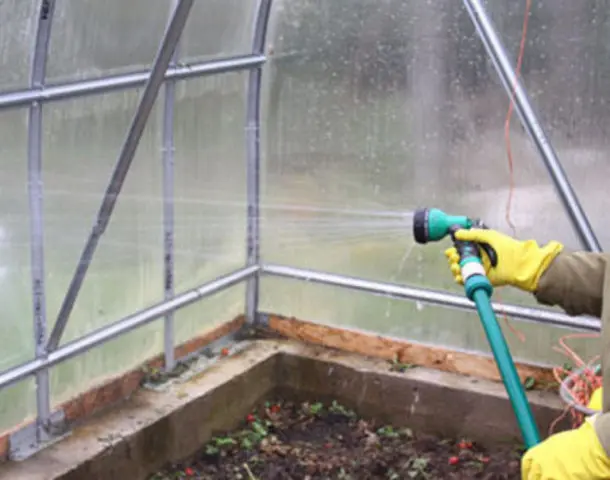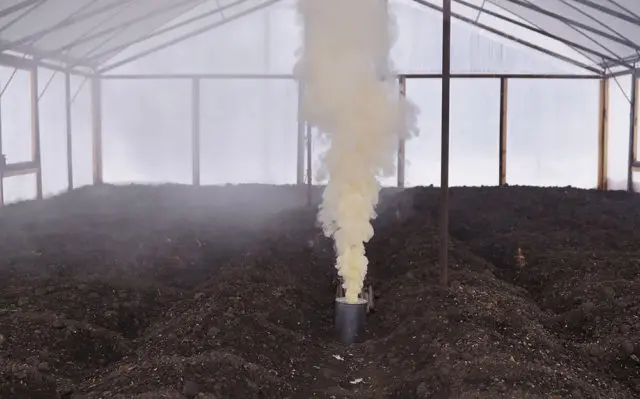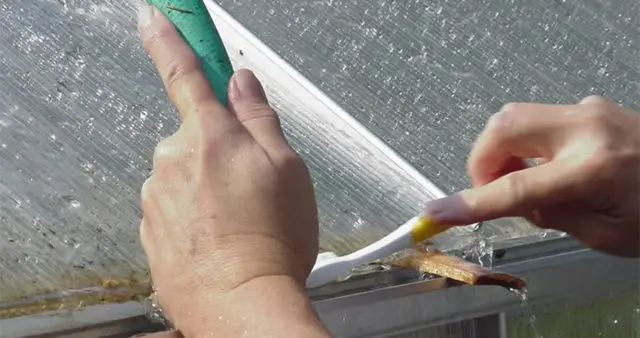Contents
You can wash a polycarbonate greenhouse in the fall using various means. Some of them are sold ready-made in specialized gardening stores, others can be diluted and prepared on their own. It is only important that washing and disinfection be done, since a fairly large amount of toxins accumulate on the walls and frame during the season, as well as harmful microflora and pathogens of various infections.
Greenhouse care after harvest
Polycarbonate greenhouses appeared relatively recently, but quickly gained popularity among both amateur gardeners and agricultural producers. Polycarbonate is quite strong, durable and reliable, and a lightweight frame made of a profiled metal pipe makes the entire structure mobile. However, during the garden season, dirt, waste products of insects, and various pathogenic microflora accumulate on the walls and load-bearing elements, which multiply intensively under conditions of high temperature and humidity.

Autumn greenhouse care includes several mandatory activities. These include:
- Cleaning of tops, fallen leaves, plant residues after fruiting crops.
- Digging up the soil, cleaning weeds and insect pest larvae.
- Disinfection or soil replacement.
- Washing walls and load-bearing structures of the greenhouse.
- Disinfection of the inner surface of the greenhouse.
If the shelter is not used in winter, various auxiliary systems can be dismantled, if any, have been installed (lighting, drip irrigation, etc.). The less cluttered the interior space, the easier it will be to wash and disinfect it.
Do I need to take care of the greenhouse
If you do not wash the polycarbonate greenhouse in the fall and do not remove all organic residues from it, next year greenhouse crops will be provided with a whole “bouquet” of various diseases. It is very important to carry out a kind of general cleaning at this time, while disinfecting not only the greenhouse soil, but also all the elements of the structure.
When is the best time to wash the greenhouse: in autumn or spring
Washing and disinfection of a polycarbonate greenhouse is best done in the fall. This is due to many factors. One of them is free time, which is much more in autumn, which means that all processing and disinfection work can be carried out slowly and with the desired quality.
It is also important that chemicals that can be used for washing and disinfection, even if they enter the soil before spring, are guaranteed to decompose and will not cause any harm to future crops.
Do I need to wash the greenhouse after harvesting?
The time after harvesting in autumn is the most optimal time for washing and disinfecting the greenhouse. During this period, it is easier to remove all organic remains from the walls and frame, if you leave them until spring, they will petrify and it will be much more difficult to wipe them off. Here is a direct analogy with dirty dishes, which are much easier to wash after eating than to soak dried food residues later.
Preparing the greenhouse for disinfection
In order to carry out high-quality disinfection of the internal space, everything unnecessary must be removed from the structure, if possible, leaving only bare walls. Before starting processing, it is necessary to remove the garters, remove the nets, remove the trellises. If auxiliary systems are installed inside, it is advisable to disassemble them and take them out of the room.
How to disinfect a greenhouse in autumn
Before disinfection, the entire surface, as well as the frame, must be thoroughly washed. After washing, disinfection can be carried out. For processing, chemical and biological preparations are used.
Polycarbonate greenhouse disinfectants in autumn
There are quite a few ways to disinfect a polycarbonate greenhouse in the fall. Here are some of the compounds with which you can carry out sanitization:
- copper sulfate;
- sulfur checker;
- potassium permanganate;
- bleaching powder;
- cutting sulfur.
If the structure is old, badly neglected and has not been disinfected for a long time, then formalin is used to process it. This is a potent substance, but it will kill not only harmful, but also beneficial microorganisms.
sulfur checker
An effective method to decontaminate a greenhouse in the fall, simple and reliable, but absolutely not applicable to structures with a metal frame. In the process of fumigation, the checker emits sulfur dioxide, which, when interacting with water, turns into acid. The contact of such drops on metal elements leads to very strong corrosion, which cannot be stopped.

To disinfect a polycarbonate greenhouse in autumn, it is sealed with adhesive tape, and sulfur bombs, the number of which is calculated from the formula 100 g of active substance per 1 m3 of volume, are evenly placed on iron stands and set on fire. After making sure that the reaction has begun and the checker has begun to emit smoke, the doors are closed. In this state, the room should be 3 days, after which it is ventilated.
Cuttings sulfur
To fumigate with cuttings sulfur, you will need to mix it in equal proportions with charcoal and grind it. The mixture is poured onto metal baking sheets and evenly distributed over the area. In total, it will be necessary to take 10 kg of sulfur for every 3 m1 of greenhouse volume.
The principle of operation is similar to a sulfur checker, therefore this method is also contraindicated in greenhouses on a metal frame. The ignited sulfur is left in a hermetically sealed greenhouse for 3-5 days, during which time not only the surface of the greenhouse, but also the soil in it will be disinfected. After that, the doors are opened. It is necessary to ventilate the building for several weeks, all work in it must be stopped for this time.
Copper sulfate
Copper sulfate is an effective broad spectrum fungicide. To prepare a treatment solution, you need to take 100 g of powder per 10 liters of water. Disinfection of the greenhouse in the fall with copper sulphate is carried out using a spray gun, sprayer or sprinkler of any type.

Bleaching powder
To treat the surface of the greenhouse with a solution of bleach, you will need to dissolve 0,4 kg of the substance in 10 liters of water. After that, the mixture should be left for several hours to settle. Then carefully drain the solution from the sediment and use it to treat the interior. The sediment can be used for whitewashing wooden structures. After processing, the greenhouse must be closed for several days.
potassium permanganate
Potassium permanganate is a well-known potassium permanganate. This drug is sold in pharmacies and is a fairly strong disinfectant. To disinfect greenhouses after harvesting in the fall, potassium permanganate is diluted to a bright pink color, after which the walls and frame are treated with a brush or spray gun. In addition to disinfection, potassium permanganate also enriches the soil with microelements.
Repair and processing of the greenhouse frame
During operation, the frame suffers almost more than the covering material. The metal profile collapses and rusts, the wood rots and turns into dust under the influence of high temperature and humidity. In autumn, you should pay special attention to this. The metal profile must be cleaned of rust and painted. Wooden elements that have become unusable must be replaced.

The points of contact of the frame elements with polycarbonate sheets are the most polluted, since many different harmful microflora are stuffed into such gaps. Therefore, it is necessary to treat such places especially carefully, not sparing the disinfectant solution.
How to wash a polycarbonate greenhouse in autumn
You can wash the polycarbonate greenhouse in the fall with warm water and laundry soap. You can also use liquid detergents, for example, for washing dishes, such as Glitter, Fairy and others.
How to wash a polycarbonate greenhouse in autumn
The detergent dissolved in water is applied to the walls and frame elements in the form of foam with a large brush or foam sponge, and after 10 minutes it is washed off with clean water from a hose. Increased attention should be paid to the processing of joints, places of contact of polycarbonate with the frame, crevices and corners, since in these places the greatest accumulation of dirt is observed.

Handling auxiliary elements
Everything that is in the greenhouse during the season (containers, utensils, inventory, nets, trellises, etc.) is contaminated with pathogenic microflora no less than the soil or the walls of the greenhouse. Therefore, after all work in the greenhouse is completed, these auxiliary elements must also be put in order, washed and sanitized.
Plastic containers and nets must be cleaned, washed, disinfected with a solution of any fungicide (for example, copper sulfate) and dried. All the ropes that were stretched in the greenhouse, as well as the wooden pegs to which the plants were tied, must be burned. This, in fact, is a consumable material and there is no point in disinfecting it. But you don’t need to reuse them, because there are no less harmful bacteria on them than on the soil.
Conclusion
It is recommended to wash the polycarbonate greenhouse in the fall, as well as to disinfect it, even in those cases when there were no diseases in the grown plants during the season. This is a very effective preventive measure, which allows not only to get aesthetic pleasure from the look of shiny polycarbonate, but also to prevent the occurrence of dangerous diseases that can significantly reduce or even destroy the entire crop. A clean greenhouse is a guarantee of the gardener’s peace of mind.









